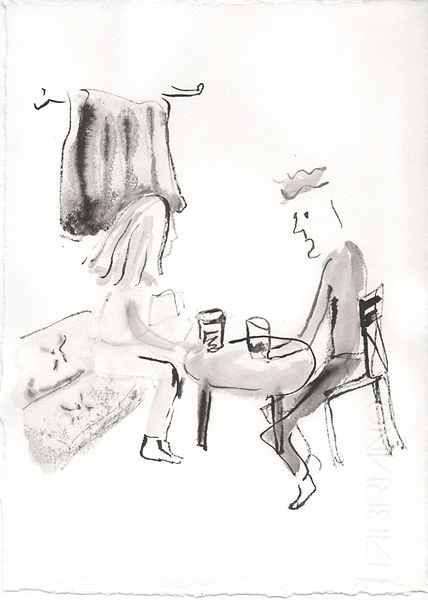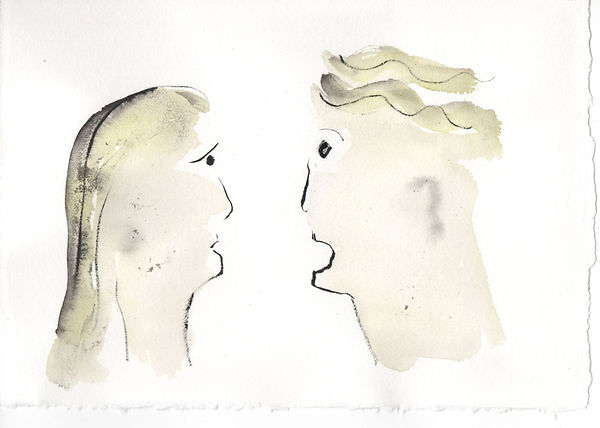

LOVE ON THE ISLE OF DOGS is a true story about love and learning about psychosis. It's a poetic tale told in pictures.
Distributed by The Book Depository
LOVE ON THE ISLE OF DOGS is both a graphic novel and a literary novel. First it's told in pictures, then in text. Two different versions of the story which shed light on the others.
It surprised me that I wrote a tear-jerker. I would never have thought that I was that kind of artist. But when a few fellow artists wanted to create a little show about depression - in a toilet! - called the Loovre - I decided to draw this awful experience. Once I started, I couldn't stop.
the pictures came first then the text. It's a harrowing tale but it's one that happens to many in one way or another but of which we rarely speak. I think it's important for people like me, who have been through this experience to share it.
The story is set against the backdrop of the Isle of Dogs in the 1990s. While construction of the Docklands, led by Canary Wharf, was going up, the foundations of my marriage turned out to be worse than built on sand. So many stories of life on the Isle of Dogs - all worthy of being told. I feel lucky that I was able to share mine.
This is also one story of the Irish community in London of the pressures on those who lived in northern Ireland through the 1970s, the generations who moved to London to escape the life, the relationship of Irish men (particularly men in this instance) and the building trade.
I write poetry and by marriage became related to John Montague, a leading Irish poet. This is a tale of how our families, Scottish and Irish, became connected. My father was in Belfast when I was a child and I always wished to go and learn more about Irish culture. I play Irish fiddle too, my tutor is Kevin Burke from the Bothy Band, so this came true.
Scroll down for sample pages and reviews/quotations.
Michele Kirsch, author of CLEAN (Short Books) winner of the 2020 Christopher Bland Prize.
Montague has an unnerving eye for the detail of situations that would floor most of us; the mental health practitioner asking her if she were OK about having her still seriously unwell partner back home, and the realisation that love could not fix all broken things.
She concludes, "How fragile is the line between happiness and unhappiness," a painfully simple truth most of us ignore, because if we lived by it, none of us would ever do anything.
I am grateful that Montague has made a such an exquisite book, reminding us of this simple truth.
Never Iron Anything
"A frankness of the realities of urban living and the rollercoasters of relationships but mixed with the romantic and fantastical. You feel the often very painful life in each paragraph. Jude shapes this prose with quick and exceptionally well crafted paragraphs"
Love on the Isle of Dogs - Never Iron Anything
Broken Frontier
On the surface, Love on the Isle of Dogs is a story about love that constantly interrogates itself, asking even in the beginning: “What & Who is Love anyway?”. This interrogation is reflected in the act of recollection itself, as Montague reflects upon her relationship with a man suffering with extreme paranoia, among other mental health issues, following from a head trauma. On this deeper level, Love on the Isle of Dogs is about truth as much as it is about love, and maybe even more so. It is about hard truths, subjective truths, and the colliding truths of two souls trying to form an unbreakable union together, using love to stitch the pieces together.
This calls to mind the writing of the Existentialist philosopher Jean-Paul Sartre who, in his prose work Nausea, discussed the human inclination to force a narrative lens onto our experiences: “This is what fools people: a man is always a teller of tales, he sees everything that happens to him through them; and he tries to live his own life as if he were telling a story”. Comics are, of course, one such medium that allow us to structure our experiences sequentially. Yet, Love on the Isle of Dogs holds itself accountable to this notion of an imposed narrative. First, we are given the illustrated version of events, and then the written account. This comparison allows the reader to consider the functionality of the comic form whilst testifying to comics’ versatility and ability to do things that prose narrative alone cannot. In fact, you feel obliged to reread the comic after the insights revealed in the prose: to put more pieces of Montague’s world together.
Rebecca Burke, Broken Frontier
Galway Literary Review
When you have drawn breath in awe at the ending of Love on the Isle of Dogs, a memoir of life in the nineteen nineties in word and picture, you know you held in your hands the life of a young woman dripping with all the blood sweat and tears that goes with being human, with being a woman whose tale it is. Hamlet’s ‘slings and arrows of outrageous fortune’ goes on and on and I can guarantee you that the proof of his words is brought home to us as the life experiences of Jude Cowan-Montague are revealed to us in this short gallop through a decade in time. Once we are in we are in, in this book and there is no backing out. We feel committed to continue with her on her journey to love and peace through the pages.
We are invited to share all the joys of her developing love life, to all the fun as she describes her wedding and the ‘can’t wait for it to happen!’ birth of her daughter. Along the way we are shocked by her troubles in the domestic front, by the onset of her husband’s’ mental illness and its worsening as time went by turning their new home into a house of horrors during sleepless nights. She would creep like a mouse around the house in the daytime for fear of sparking off his anger.
All of this was happening until he agreed to be hospitalised and he was diagnosed with paranoid schizophrenia. Her memoir undoubtedly raises questions on how we view issues of mental health and its treatment.
We are treated to her artistically drawn black and white skip along pictures in part one, a walk- around-gallery depicting the various stages of her life expressed in the same sequence as her written story in part two. The drawings are in the realm of art therapy for both writer and reader.
It’s both a great introduction and a useful guide to keep us on track with all that was happening.
‘I jumped from tussock to tussock on the marches and never twisted my ankle’.
This agility appears to me to be paralleled in the style of her narration. She moves quickly from one account to another with the same skill, ease, and quickness shown in her sure-footedness across the moors of her native Manchester. Though this sure-footedness sometimes faltered as she was faced with a brick wall of adversity at later times on various occasions.
She paints a very poignant picture of herself at the end of the book in the Epilogue, a statuesque image of her alone with her baby in the snow. I am reminded of what she said earlier in dire straits, ‘The first rule is to protect yourself and your children’. It is the picture of the survivor of a troubled marriage now facing life alone with her daughter:
‘Above me the flakes of winter were falling. They landed on my hair, they landed on my shoulders, they landed on my sleeves’.
Matt Mooney



